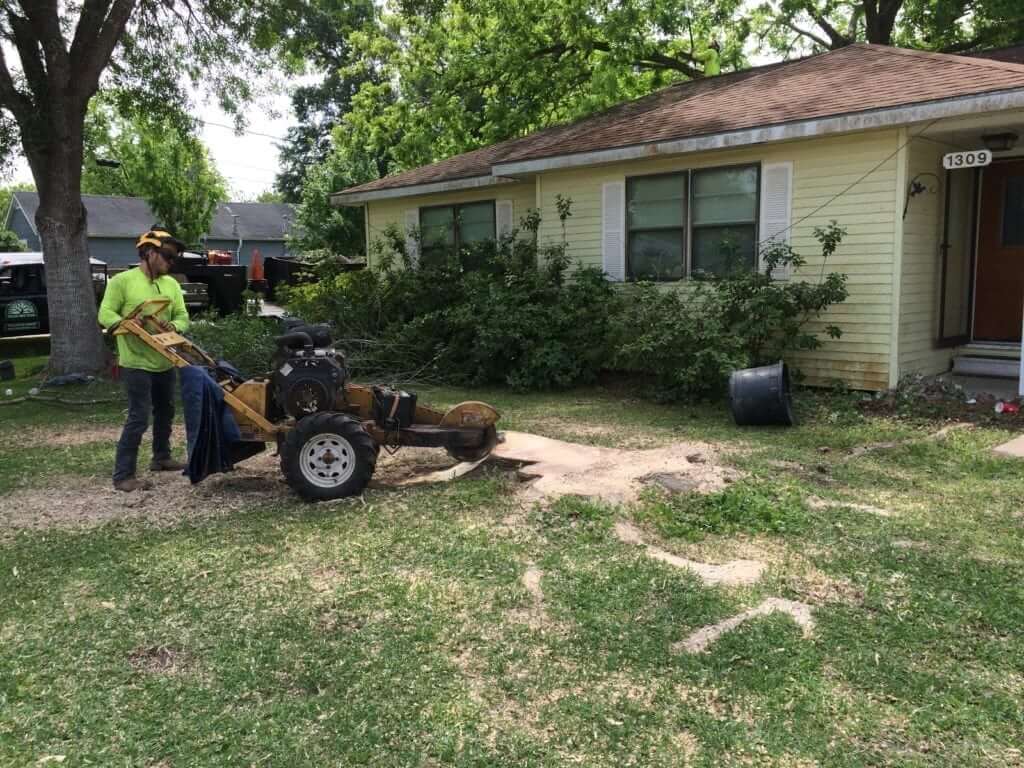Stump grinding is a crucial step in the process of removing tree stumps from your property. Whether you’re clearing space for a new construction project or simply looking to improve your landscape, understanding the cost involved in stump grinding is essential. The cost to grind stumps can vary depending on several factors that need to be considered. In this article, we will dive into the basics of stump grinding and explore the different factors that can impact the overall cost. Additionally, we will discuss ways to save on stump grinding, ensuring that you make an informed decision that suits your needs and budget.
The Basics of Stump Grinding
Before delving into the factors of cost to grind stumps, it’s important to understand what stump grinding entails. Stump grinding is the process of using specialized machinery to grind tree stumps down to ground level. This effectively removes the visible portion of the stump, allowing for a clean and level landscape. Stump grinding is typically performed by professional arborists or stump grinding companies who possess the necessary experience and equipment to carry out the task efficiently.
What is Stump Grinding?
Stump grinding involves the use of a stump grinder, which is a powerful machine equipped with a rotating cutting wheel. This cutting wheel has sharp teeth that grind away the stump in a controlled manner. As the wheel turns, it chips away at the wood, transforming the stump into small wood chips or mulch. You can visit https://frenchclassifiedandproperty.com/professional-stump-grinding-services-what-to-expect to get more about professional stump grinding services.
Why is Stump Grinding Necessary?
There are several reasons why stump grinding is necessary. Firstly, stumps can be eyesores that detract from the overall aesthetics of your landscape. By removing the stumps, you can create a clean and visually appealing outdoor space.
Imagine this: you have meticulously designed and maintained your garden, with beautiful flowers and perfectly trimmed hedges. But there, in the corner, stands an unsightly stump, disrupting the harmony of your landscape. By opting for stump grinding, you can bid farewell to this eyesore and restore the beauty of your outdoor sanctuary.
Additionally, stumps can pose safety hazards, especially if they are hidden beneath foliage or grass. They can cause trips and falls, particularly for children or elderly individuals.
Picture this: your children are running around, playing tag in the backyard. Suddenly, one of them trips over a hidden stump and falls, scraping their knee. Not only does this ruin the fun, but it also poses a potential risk for more serious injuries. By grinding the stumps, you can ensure a safer environment for your loved ones to enjoy.
Furthermore, stumps can impede construction or landscaping projects, making it difficult to create a level surface or plant new trees and shrubs.
Imagine you are planning to build a patio in your backyard, or perhaps install a new flower bed. However, the presence of stubborn stumps makes it nearly impossible to achieve a smooth and even surface. By grinding the stumps, you can eliminate these obstacles and make way for new growth.
So, whether you want to enhance the aesthetics of your landscape, ensure the safety of your loved ones, or create a level surface for your next project, stump grinding is a necessary step towards achieving your goals.
The Cost Factors in Stump Grinding
Now that we understand the basics of stump grinding, let’s explore the different factors that contribute to the overall cost of the process.
Stump grinding is a meticulous process that involves the complete removal of a tree stump from the ground. This task requires specialized equipment and skilled professionals to ensure a thorough and efficient job. Understanding the cost factors involved can help property owners make informed decisions when it comes to stump removal.
Size of the Stump
One of the primary factors that impact the cost of stump grinding is the size of the stump. Larger stumps require more time and effort to grind down, which can increase the cost. The size of a stump is usually measured by its diameter at ground level. Most stump grinding services charge based on the stump’s diameter, with higher rates for larger stumps.
Additionally, the depth of the stump and the root system can also influence the overall cost. Deeper roots or extensive root systems may require more time and effort to grind, leading to higher costs for the property owner.
Number of Stumps
The number of stumps you need to grind will also affect the overall cost. Many stump grinding companies offer discounts for multiple stumps, as it allows them to efficiently complete the job without constantly setting up and dismantling equipment. If you have multiple stumps on your property, it’s worth considering having them all ground at once to save on costs.
Location and Accessibility of the Stump
The location and accessibility of the stump play a significant role in determining the cost of grinding. Stumps that are easily reachable and located in open areas are generally easier and quicker to grind, resulting in lower costs. However, if the stump is located in a hard-to-reach area, such as a fenced backyard or a tight corner, additional labor and equipment may be required, increasing the overall cost.
Furthermore, the presence of obstacles like rocks, concrete, or underground utilities near the stump can also impact the cost of grinding. Clearing these obstacles or working around them requires extra care and effort, potentially adding to the total expenses of the stump removal process.

Equipment and Labor Costs
Aside from the factors mentioned above, the type of equipment used and the labor costs associated with stump grinding also contribute to the overall cost.
Types of Stump Grinders
There are various types of stump grinders available, ranging from handheld machines to large self-propelled models. The choice of stump grinder depends on the size and complexity of the stumps to be ground. Larger stump grinders tend to be more expensive to rent or operate, adding to the overall cost.
Handheld stump grinders are compact and easy to maneuver, making them suitable for small-scale stump removal projects. They are typically less expensive to rent or purchase compared to larger models, but may take longer to grind larger or tougher stumps due to their lower power output. On the other hand, large self-propelled stump grinders are equipped with powerful engines and cutting mechanisms, allowing them to tackle large stumps efficiently. However, their size and weight may limit access to tight or confined spaces, potentially increasing the complexity and cost of the job.
Labor Costs and Time Investment
Stump grinding requires skilled labor to operate the machinery safely and effectively. Arborists or stump grinding professionals typically charge for their services based on the time taken to complete the job. The complexity of the stumps and the level of experience required can impact labor costs, so it’s important to factor this into the overall cost estimation.
Furthermore, the time investment involved in stump grinding can vary depending on the number and size of stumps to be removed. Larger or multiple stumps may require more time to grind, leading to higher labor costs. Additionally, the presence of obstacles such as rocks, roots, or underground utilities near the stumps can prolong the grinding process, requiring more expertise and potentially increasing the overall cost of the project.
Additional Costs to Consider
In addition to the primary cost factors, there are some additional costs that you should be aware of when planning for stump grinding.
When budgeting for stump grinding, it’s crucial to factor in any potential additional costs that may arise during the process. These costs can vary depending on the size and location of the stump, as well as the specific services offered by the stump grinding provider.
Cleanup and Disposal Fees
After the stumps are ground, there will be a significant amount of wood chips or mulch generated. Some stump grinding services include the cleanup and disposal of these materials in their pricing, while others may charge an additional fee. It’s important to clarify this with the service provider to avoid any unexpected costs.
Professional stump grinding companies often have specialized equipment to efficiently remove the wood chips and debris left behind after the grinding process. This cleanup and disposal service not only saves you time and effort but also ensures that your property is left clean and tidy once the job is complete.

Landscaping and Repair Costs
Stump grinding can leave behind a large hole where the stump once stood. Depending on your plans for the area, you may need to fill the hole, level the ground, or allocate resources for future landscaping. These additional landscaping and repair costs should be considered when budgeting for stump grinding.
It’s essential to assess the impact of stump grinding on your landscape and budget accordingly for any necessary repairs or enhancements. By factoring in these landscaping costs from the outset, you can ensure that the area where the stump once stood is seamlessly integrated into your outdoor space, enhancing its overall aesthetic appeal.
Ways to Save on Stump Grinding
While stump grinding can be a significant expense, there are ways to save on the cost without compromising on quality.
When it comes to saving on stump grinding, one option to consider is DIY stump grinding. If you have experience operating heavy machinery and access to a stump grinder, you may be able to tackle the job yourself. DIY stump grinding can save you on labor costs, but it’s crucial to ensure that you have the necessary skills and safety precautions in place. Before taking on this task, it’s important to familiarize yourself with the proper techniques and safety guidelines to avoid any accidents or injuries.
Another factor to consider when deciding between hiring a professional or doing it yourself is the number of stumps you need to grind. If you have multiple stumps on your property, renting a stump grinder and handling the task yourself may be more cost-effective. However, if you only have one or two stumps, hiring a professional stump grinding service might be a better option. Professionals have the experience and expertise to efficiently complete the job, minimizing any potential risks or damage. Moreover, they possess the necessary equipment to handle stumps of various sizes and complexities.
While DIY stump grinding can be appealing for budget-conscious individuals, hiring a professional stump grinding service offers several benefits. Not only do professionals have the necessary skills and equipment, but they also save you time and effort. Grinding a stump can be a time-consuming process, especially if you’re not familiar with the equipment. By leaving it to the professionals, you can focus on other tasks or simply relax and enjoy your free time.
Additionally, hiring a professional can help you avoid any potential damage to your property. Stump grinding requires precision and careful maneuvering to ensure that surrounding structures, such as fences or underground utilities, are not affected. Professionals are trained to handle these situations and can minimize any risks or accidents that may occur during the process.
In conclusion, understanding the cost to grind stumps involves considering various factors such as the size of the stump, the number of stumps, and the location and accessibility. Additionally, the type of equipment and labor costs contribute to the total cost. It’s important to factor in additional costs such as cleanup and disposal fees, as well as potential landscaping and repair expenses. By exploring ways to save on stump grinding, such as DIY options or hiring professionals, you can find a solution that suits your budget while ensuring a clean and beautiful outdoor space.
Other resources: SWIMMING POOL SAFETY REGULATIONS IN FRANCE





